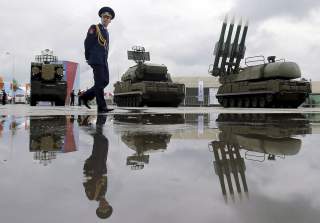Averting the U.S.-Russia Warpath
Even as U.S.-Russian tensions have risen, fundamental shifts in the military-technological environment threaten to erode strategic stability between the two nations.
The United States should also invest in its missile-defense architecture. To start, as North Korea improves its nuclear-tipped ICBM capabilities, the United States should continue to grow its missile defenses. Second, the United States should continue to press forward with directed-energy systems for defensive purposes. Priority should be given to helping to deal with the immediate challenge of negating North Korean long-range and medium-range missiles, likely by deploying directed-energy systems on manned or unmanned aircraft. Third, the United States should forswear space-based missile defense interceptors and directed-energy systems, strongly urge Russia to do the same and pursue a bilateral agreement with Russia (and, separately, a bilateral agreement with China) to this end. Because of the massive and immediate threat that such systems would pose to American satellites and their essential support to warfighting—and potentially to early warning and secure communications satellites that are vital to the U.S. nuclear deterrent—any Russian deployment of space-based missile defense interceptors or lasers would pose an immediate and unacceptable threat.
Finally, the United States should regularize strategic-stability talks with Russia and seek to extend the New START treaty by five years. The U.S.-Russian meeting in Finland in September 2017 was an important first step toward a regular Track 1 dialogue on strategic stability issues in the coming years. The American and Russian governments should sustain these sorts of efforts. At the same time, however, in view of the volatility of U.S.-Russian relations at this time, and recognizing that circumstances may delay or derail Track 1 efforts, both parties should pursue Track 2 and Track 1.5 dialogues on strategic stability. Extending New START would serve strategic stability through its verification provisions, which provide transparency and predictability, thereby reducing the propensity of each side to rely on worst-case assessments. It would not currently be helpful to press for further reductions in force levels, as having some extra margin above the bare minimum force levels that each side thinks it needs will help buffer the impact of new military capabilities as they are deployed.
THE UNITED States and Russia have reentered a period of serious tension that shows no sign of abating. Relations between the two sides appear likely to remain tense, if not hostile—at least through the medium term—and may involve considerable turbulence. Bluntly put, serious disagreement and even outright conflict are possible. Exacerbating this geopolitical reality, emerging new military capabilities—cyber, space, missile defense, long-range strike and (cutting through all) autonomous systems—are increasing uncertainties associated with strategic stability. Unless measures are taken to cushion the consequences of these military trends, conflict may become more probable and escalation more dramatic and severe than they need to be—all in an era when both crisis and conflict are more plausible than they were just ten years ago. If adopted by the Trump administration and its successors, a fresh American approach to U.S.-Russian relations will protect American and allied interests. If the U.S. approach is also articulated clearly and is consistent over time, it may well reduce the risk of crisis or conflict arising from Russian miscalculation.
James N. Miller is president of Adaptive Strategies, LLC, a senior fellow at Harvard Kennedy School’s Belfer Center and served as under secretary of defense for policy. Richard Fontaine is president of the Center for a New American Security. Alexander Velez-Green is a research associate at the center.
Image: Reuters

